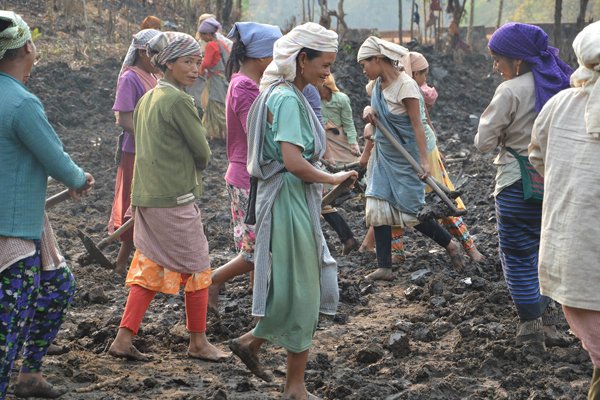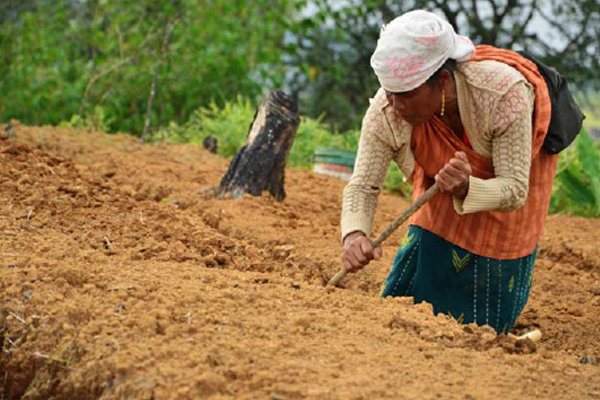Case Study: The Success of Niriang INRM Initiative

From being water-deficient to becoming water-surplus, this is the story of a village called Niriang in West Jaintia Hills District.
Despite receiving high rainfall, water scarcity has become an issue across the State, especially in recent years. Natural springs and underground water are drying up due to a dearth of corrective and remedial measures. The problem is intensifying with every passing year and may become unmanageable if due attention and collective efforts from all concerned are not carried out.
Situated 10 kilometers from Jowai, the district headquarters of West Jaintia Hills, Niriang village under Thadlaskein Block also struggled with water supply. Though rich in vegetation with beautiful landscapes, the village had to contend with this issue for years. An intervention had earlier been put in place but the water supply was inadequate due to disrupted services and a poor connection that could not cater to the entire village. It did not cover the daily requirements for domestic purposes and left its resident dependent on springs and wells. Moreover, with the increase in the number of households, now totaling 224, the water needs also increased. And those residing farther from the water source would need to travel at least 30 minutes to fetch water, to and fro, three times to four times daily, and carried out by women and children.
Before Intervention:
Niriang has a perennial spring which is located at a hilltop making it quite tedious to fetch water. It may be mentioned that the land where the spring originates belongs to the community. As Niriang is a Megha-LAMP village, a plan was prepared to initiate different interventions that will address the issue holistically and uplift the living conditions of the people.
Hence, it was in 2019, following several rounds of awareness programs, meetings, and PRA exercises, led by the District Project Management Unit (DPMU) of West Jaintia Hills District that the village agreed on the implementation of a community-led NRM plan under Megha-LAMP. The village came up with a priority list of interventions that included tapping the perennial spring via the construction of a water tank that has since gone a long way in resolving the issue.
About the Intervention:
A preliminary survey to understand clearly the kind of intervention that will be most sustainable and productive was made by the INRM staff of Megha-LAMP stationed in Jowai. They were ably assisted by the community of Niriang. Meetings and awareness programs were then conducted to clear doubts, elucidate the approach, and identify community needs based on priorities. Following several deliberations, a final plan was prepared together by the project and the community.
A site inspection to study the feasibility before work started was the first step. The findings revealed that for best long-term results, a spring chamber box and a water storage tank must be constructed. GI Pipes will be used to draw water from the spring to the tank without using a mechanical pump as the spring is located at an elevated area while the water storage tank will be constructed on a lower ground level. This will help to protect the spring water from contamination.
Budget Allocation:
The spring chamber box was constructed through convergence between Megha-LAMP, MGNREGA, and the community of Niriang. The total cost of construction was ₹ 48,210.00. The break-up of the budget was Megha-LAMP: ₹ 19,326, MGNREGA: ₹ 25,984, and Community Contribution: ₹ 2,900.00.
The water tank is a permanent structure to store water for supplying to the community. This project was also constructed through convergence between Megha-LAMP, MGNREGA, and Community Contribution. The total cost of construction was ₹ 1, 25,650. The breakup of the budget was Megha-LAMP: ₹ 49,130, MGNREGA: ₹ 69,020, and Community Contribution: ₹ 69,020.00.
The GI Pipes were installed by Megha-LAMP and the community. Megha-LAMP’s contribution was ₹ 1, 28,430, and community contribution was ₹ 22,600. The total cost was ₹ 1, 51,030. All work was completed in the course of 2 months, starting on 3rd December 2020 and ending on 3rd February 2021.

The water source protected with cemented plastering
Impact:
The NRM intervention at Niriang has since proven to be very beneficial for the village as a whole. Smt. Baian Blah (MCS) Block Development Officer, Thadlaskein stated her contentment with how enormously the intervention has helped the people. “The village had been struggling with water shortage considerably, but now, it is pleasing to witness reliable water supply all through the year.” She added that the significance of the project was that it is demand-driven, which meant that the people were given the lead to select the kind of interventions that would best serve their needs. Blah is working towards facilitating more convergence works between departments and livelihood-promotion institutions such as Megha-LAMP to address other needs of the village.
Echoing similar views, the VEC Secretary who is also the Village Facilitator (VF), Bah Praising Muruh mentioned that since the implementation of the project, the village has changed from a water-deficient to a water surplus village. “With readily available water supply to all corners of the village, we are encouraged to see people spread out and settle in other parts of the village, which previously were areas not feasible for settlement given the absence of a trusted water connection”.
Kong Redial Suting, a resident of the village, expressed her happiness with the success of the project in bringing about a positive change in their village. “We no longer need to travel up the hill to fetch water. The drudgery has been reduced by a great extent. We can now utilize our time in gardening, household chores, and other activities”
Way Forward
With their water issue firmly behind, the community’s focus has shifted. The awareness programs and capacity-building exercises provided to the Village Facilitators, the Watershed volunteers, the VEC members, and their people have helped them understand the impending impact of climate change on their flora and fauna, their water bodies, and their natural resources. In preparation, the village is taking active steps to protect their catchment areas and are carrying out regular tree plantation drives. The community remains open to working in partnership with various projects and government departments so that they are facilitated with adaptation measures to climate change.


